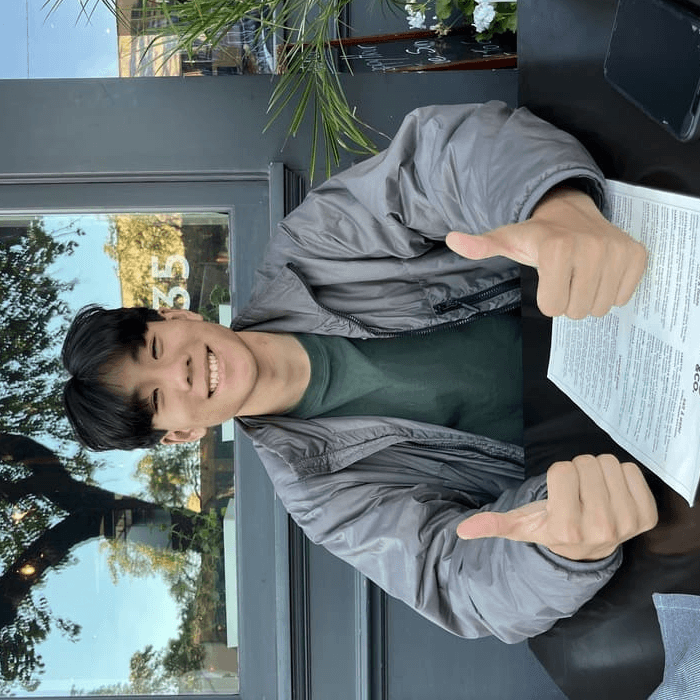< Back
How To Use Transition Sentences To Improve Your Writing
Declan Gessel
Apr 19, 2024
Transition sentences are essential in every essay as they help to create a smooth flow of ideas and thoughts - this is why you should aim to build a better understanding of how to write an essay. Used properly, they will make your writing clearer and more coherent by helping to link together different ideas, topics, and sections. Transition sentences are not just the little words that connect thoughts; they are the glue that binds them together in a coherent and efficient way. Let's look at the different transition words to help you in your creative writing.
Table of Contents
Using A Variety Of Transition Sentences To Improve Your Writing
How to Analyze Sentence Connections For Choosing the Best Transition Sentence
Write Smarter Transition Sentences With Jotbot — Start Writing for Free Today
Why Transition Sentences Matters

Flow is crucial in writing. It refers to the smooth and logical progression of ideas from one point to the next. Without flow, ideas become disjointed and difficult to follow, leading to reader confusion and disinterest. Transition sentences play a key role in maintaining flow in writing by connecting different concepts, themes, and arguments. They are the lubricant that greases the wheels of written communication, making it easier for readers to understand and engage with the text.
The Importance of Transition Sentences
Transition sentences prevent abrupt stops in the text, creating a clear path for the reader to follow. By introducing a new idea or connecting one to the next, they help maintain the reader's attention and guide them through the text.
Without transition sentences, readers can become lost in the sea of disconnected ideas, struggling to make sense of the writer's message. This can result in reader frustration and disengagement, leading to a negative impact on the effectiveness of the written communication.
Enhancing Readability and Engagement
Ensuring that transition sentences are used effectively can significantly improve the readability, engagement, and persuasiveness of the writing. When ideas flow logically from one to the next, readers are more likely to stay engaged with the text, increasing the chances of them absorbing and retaining the information presented.
Transition sentences can also help build a coherent argument or narrative, making the text more persuasive and convincing. Transitions play a critical role in enhancing both the clarity and flow of ideas in written communication, improving the overall quality and impact of the writing.
Related Reading
• Argumentative Essay
• Essay Format
• Expository Essay
• Essay Outline
• How To Write A Conclusion For An Essay
• Narrative Essay
• Rhetorical Analysis Essay
• Persuasive Essay
Different Types of Transition Sentences With Examples

Chronological Transitions
Chronological transitions help the reader understand the order of events or ideas in a sequence. They offer a clear roadmap through your writing, making it easy for your audience to follow your train of thought. These transitions help you craft a coherent and logical narrative that's easy to understand. Using them ensures your readers don't get lost in your content, creating a seamless flow from one idea or event to the next.
Cause & Effect
Cause-and-effect transitions are vital for explaining the relationship between two or more ideas, events, or conditions. They help your readers understand why one event led to another, or why one idea naturally follows another. Simply put, they make your writing make sense. Using them improves the clarity of your content by helping your audience draw connections between the different elements in your text.
Contrast
Contrast transitions are used to show the differences between ideas or viewpoints. They help highlight opposing ideas, creating a stark, clear distinction between them. These transitions are perfect for drawing attention to a change in direction or tone in your writing. They allow you to effectively transition from one idea to its opposite, helping to emphasize the differences and create a strong impact on your readers.
Similarity
Similarity transitions help you draw connections between different ideas or points in your content. They highlight similarities, comparisons, and likenesses between concepts, helping your readers see how related the different elements in your content are. Using these transitions allow you to emphasize commonalities, draw parallels between seemingly different ideas, and create a cohesive narrative that links all your points.
Emphasis
Emphasis transitions are all about highlighting or strengthening a particular point in your content. They help you underscore the significance of a specific idea, fact, or argument. Using these transitions allows you to draw attention to crucial elements in your writing, making them stand out from the rest of your content. They empower you to ensure your readers focus on the key points in your content, helping them retain the essential information you're delivering.
Examples of Transition Words and Phrases
Chronological Transitions
Example Sentence: "We gathered our supplies first. Next, we packed our backpacks. Finally, we set off on our adventure."
Cause & Effect
Example Sentence: The factory was polluting the river. Therefore, the fish population began to decline.
Contrast
Example Sentence: Exercise can be tiring, however, the benefits outweigh the effort.
Similarity
Example Sentence: A healthy diet is important for physical health, similarly, it's crucial for mental well-being.
Emphasis
Example Sentence: Recycling is essential for environmental protection. It can save money on resource consumption.
Choosing the Right Tool
Analyzing the Connection Between Sentences
When selecting the right transition word, examine the relationship between the sentences. Consider how the ideas in your content connect. Are they presenting similar ideas, contrasting viewpoints, or emphasizing specific points? Analyzing the connection between sentences will help you choose the transition word that best suits the relationship between the ideas you're presenting.
Decision-Making Framework
To guide your selection of the right transition word, follow a decision-making framework. Start by identifying the connection type between the sentences. Determine if they are chronological, cause and effect, contrasting ideas, showing similarity or emphasizing a point.
Once you've identified the relationship, select the transition word or phrase that best represents this connection. Using a structured framework will help you choose the most suitable transition words for your content.
Jotbot is your personal document assistant
Jotbot does AI note-taking, AI video summarizing, AI citation/source finder, it writes AI outlines for essays and even writes entire essays with Jotbot’s AI essay writer. Join 500,000+ writers, students, teams, and researchers around the world to write more, write better, and write faster with Jotbot. Write smarter, not harder with Jotbot.
Start writing for free with Jotbot today — sign in with Google and get started in seconds.
Using A Variety Of Transition Sentences To Improve Your Writing

By continually repeating the same few transition words, like "however" or "because," your writing can sound monotonous and lack variety. To avoid this, I recommend exploring a wider range of transition words with a thesaurus. Categorizing these words based on their function can encourage you to go beyond the basics. Online resources or thesaurus apps can help you discover new transition options, enhancing the depth and variety of your writing.
Seamless Integration of Transition Words
Optimal placement of transition words within sentences can significantly impact the emphasis and flow of your writing. Starting a sentence with a transition word gives strong emphasis to the transition, as in "Therefore, we must take action." Alternatively, placing the transition word in the middle or end of the sentence can create a smoother flow, like "We must take action, therefore, the evidence is clear."
To assure seamless flow and logical connections, ensure the transition word links the two sentence halves grammatically and contextually, as in "The movie was visually stunning, but the plot lacked depth."
Advanced Transition Techniques
Transition phrases, like "Considering the potential benefits," provide more context and nuance than single words. Similarly, transition clauses embed the connection within the sentence, as in "Although the initial cost appears high, the policy has the potential for long-term savings." Experimenting with sentence structure can help integrate transitions creatively, such as in "The new policy may seem expensive at first. Its long-term savings potential is undeniable."
Basic vs. Advanced Examples
Contrast basic transitions with advanced ones to showcase the impact on the writing. A basic example could be "The new policy seems expensive. It might save money in the long run." In comparison, an advanced transition could read, "In light of the initial cost, the policy has the potential for long-term savings through increased efficiency." These examples illustrate how transitioning from simple words to phrases or clauses can elevate the coherence and sophistication of your writing.
5 Easy Tips to Craft Powerful Transition Sentences

1. Bridge the Gap
Transition sentences are crucial in connecting ideas and guiding readers through your writing. Just like stepping stones that help navigate a river, transitions ensure that readers understand how each point relates to the one before and after it. Using transition sentences in this way can help readers move easily through your content and grasp key concepts quickly.
2. Mix it Up
Using a variety of transition words in your writing is key. Rather than relying solely on common transitions like "however" or "because," try experimenting with alternatives like "in addition," "for example," and "on the other hand." By using a range of transition words, you can create more engaging and varied writing that keeps readers interested and reinforces your main points.
3. Matchmaker, Matchmaker
Transitions aren't one-size-fits-all. Different transitions work better in different situations, so it's essential to understand which type of transition is best to use based on the relationship between ideas you're trying to convey.
Transitions can be used in several ways: they can signal a change in time, contrast two ideas, or establish a cause-and-effect relationship. By thinking of transitions as tools in a toolbox, you can choose the right one for the job and create clear, logical connections in your writing.
4. Weave It In
Transition sentences can be placed at the beginning, middle, or end of a sentence, depending on what you want to emphasize. Experiment with moving your transitions around to see what has the most impact. For example, placing a transition at the beginning of a sentence can draw attention to the connection you're making.
On the other hand, placing a transition at the end of a sentence can help reinforce the idea that you've just presented. By weaving transitions into your writing in different ways, you can create a more dynamic and engaging piece.
5. Practice Makes Progress
The more you practice using transitions in your writing, the better you'll become at seamlessly integrating them into your content. Try rewriting sentences or creating stories that use various transitions to reinforce the different relationships between ideas. With practice, using transitions will become second nature, and you'll be able to craft more cohesive and well-organized writing.
Related Reading
• Words To Start A Paragraph
• Essay Structure
• Types Of Essays
• How To Write A Narrative Essay
• Synthesis Essay
• Descriptive Essay
• How To Start Off An Essay
• How To Write An Analytical Essay
• Write Me A Paragraph
• How To Write A Synthesis Essay
Avoid These Five Things When Writing Transition Sentences

Overused and Clichéd Transitions
Instead of relying solely on common transition words like "however," "in addition," or "on the other hand," I strive to utilize a diverse range of transitions in my writing. By expanding my transition vocabulary, I can infuse my writing with variety and sophistication.
Mismatched Transitions
When selecting transitions for my sentences, I always ensure that the transition accurately reflects the relationship between my ideas. This ensures that my writing flows logically and cohesively, without any confusion for the reader.
Awkward Placement
While transitions are most commonly used at the beginning of paragraphs, I also integrate them within sentences when necessary. By strategically placing transitions in my writing, I maintain a smooth and cohesive flow that guides the reader through my ideas.
Redundancy and Repetition
I steer clear of using transitions that simply restate what is already evident in my sentences. Instead, I focus on incorporating transitions that genuinely connect and enhance the relationship between my ideas, preventing redundancy.
Overreliance on Transitions
I acknowledge that transitions should not serve as a crutch in my writing. By ensuring that my sentences are well-structured and logical, I use transitions strategically to amplify clarity and coherence, rather than relying on them as a substitute for effective writing.
How to Analyze Sentence Connections For Choosing the Best Transition Sentence

Identify the Main Ideas
When identifying the main ideas of each sentence, try to pinpoint what each sentence is talking about. Look for the subject, verb, and object in each sentence to understand the main idea. For example, in the sentence "I went to the store and bought some fruit," the main idea is that the speaker went to the store and bought some fruit.
Ask Yourself How They Connect
Once you have identified the main ideas of each sentence, you can start to think about how these ideas relate to each other. Do they share a cause and effect relationship, are they contrasting ideas, are they similar or do they form a sequence? By answering these questions, you can determine the relationship between the two sentences and choose an appropriate transition.
Cause and Effect
Cause and effect transitions indicate a relationship where one event leads to another. Some common cause and effect transitions include "as a result," "therefore," and "because." For example, you might use "as a result" to link the sentences "It rained heavily" and "The streets were flooded" to show that the heavy rain caused the flooding.
Contrast
Contrast transitions highlight opposing viewpoints or ideas. If you want to show that two sentences differ in some way, you might use transitions like "however," "on the other hand," or "conversely." For example, you could use "however" to link the sentences "Exercise can be tiring" and "The benefits outweigh the effort" to show that the effort of exercise is worth the benefits.
Similarity
Similarity transitions demonstrate that two sentences share similar ideas or add details to support a point. Common similarity transitions include "similarly," "likewise," and "in the same way." For example, you might use "similarly" to link the sentences "A healthy diet is important" and "Similarly, it's crucial for mental well-being" to show that both physical and mental health benefit from a healthy diet.
Chronological Order
Chronological transitions show a sequence of events or steps in a process. Transition words like "first," "next," and "subsequently" are commonly used to indicate chronological order. For example, you could use "next" to link the sentences "We gathered supplies" and "Next, we packed our backpacks" to show the order of events in preparing for a trip.
Write Smarter Transition Sentences With Jotbot — Start Writing for Free Today
Jotbot is an innovative AI tool that offers a wide range of benefits for writers, students, teams, and researchers. With Jotbot's AI note-taking capabilities, you can easily capture key information, ideas, and insights. The AI video summarizing feature allows you to condense lengthy video content into concise summaries, saving you time and effort. Jotbot's AI citation and source finder helps you locate relevant sources to support your writing.
AI Outlines for Essays
One of the standout features of Jotbot is its ability to generate AI outlines for essays. These outlines serve as a roadmap for your writing, helping you organize your thoughts and ideas effectively. By leveraging Jotbot's AI outline capabilities, you can streamline the writing process and ensure that your essay flows logically and cohesively.
AI Essay Writer
Jotbot's AI essay writer is a game-changer for those looking to boost their writing productivity. Whether you're working on an academic paper, a blog post, or a report, Jotbot's AI essay writer can help you generate high-quality content in a fraction of the time it would take to write manually. By harnessing the power of AI, you can produce well-crafted essays that meet your specific requirements and objectives.
Write Smarter with Jotbot
With Jotbot, writing smarter is not just a catchphrase – it's a reality. By automating repetitive tasks, providing valuable insights, and enhancing your overall writing experience, Jotbot enables you to achieve better results with less effort. Join the ranks of over 500,000 writers worldwide who are using Jotbot to write more, write better, and write faster.
Start your writing journey with Jotbot today and unlock your full writing potential.
Related Reading
• Critical Analysis Essay
• How To Write A Personal Essay
• Chat Gpt Essay Writer
• How To Write An Outline For An Essay
• What Makes A Good Thesis Statement
• Essay Writing Tools
• How To Write A 5 Paragraph Essay
• How To Write A Rhetorical Analysis Essay
• First Person Essay
• How To Write A Header For An Essay
• Memoir Essay
• Formula For A Thesis Statement
Write more, better, faster.
Your personal AI document assistant












